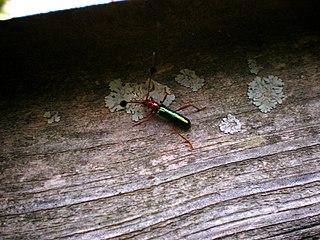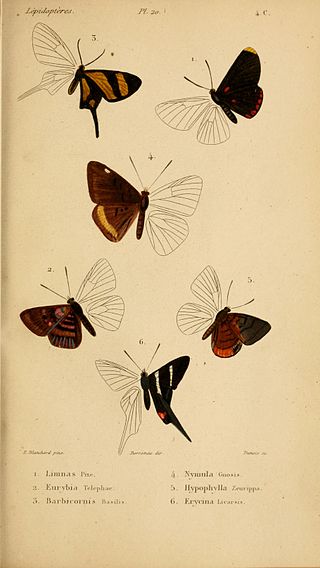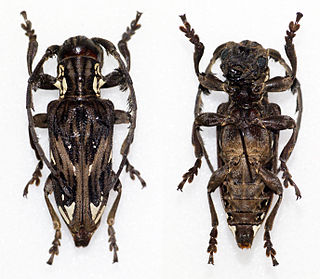
Penguins are a group of aquatic flightless birds from the family Spheniscidae of the order Sphenisciformes. They live almost exclusively in the Southern Hemisphere: only one species, the Galápagos penguin, is found north of the Equator. Highly adapted for life in the ocean water, penguins have countershaded dark and white plumage and flippers for swimming. Most penguins feed on krill, fish, squid and other forms of sea life which they catch with their bills and swallow whole while swimming. A penguin has a spiny tongue and powerful jaws to grip slippery prey.

In taxonomy, binomial nomenclature, also called binary nomenclature, is a formal system of naming species of living things by giving each a name composed of two parts, both of which use Latin grammatical forms, although they can be based on words from other languages. Such a name is called a binomial name, a binomen, binominal name, or a scientific name; more informally it is also historically called a Latin name. In the ICZN, the system is also called binominal nomenclature, "binomi'N'al" with an "N" before the "al", which is not a typographic error, meaning "two-name naming system".

Pinnipeds, commonly known as seals, are a widely distributed and diverse clade of carnivorous, fin-footed, semiaquatic, mostly marine mammals. They comprise the extant families Odobenidae, Otariidae, and Phocidae, with 34 extant species and more than 50 extinct species described from fossils. While seals were historically thought to have descended from two ancestral lines, molecular evidence supports them as a monophyletic lineage. Pinnipeds belong to the suborder Caniformia of the order Carnivora; their closest living relatives are musteloids, having diverged about 50 million years ago.

The International Union for Conservation of Nature (IUCN) Red List of Threatened Species, also known as the IUCN Red List or Red Data Book, founded in 1964, is an inventory of the global conservation status and extinction risk of biological species. A series of Regional Red Lists, which assess the risk of extinction to species within a political management unit, are also produced by countries and organizations.

The giraffe weevil is a species of weevil endemic to Madagascar. These small weevils are black bodied with bright red elytra covering their wings. Giraffe weevils are known for their elongated necks, with the males having necks 2 to 3 times the size of their female counterparts. There are several advantages to their elongated necks including using them for combat, attracting mates, building nests, and acquiring resources. In the field of coleopterology, giraffe weevils are of interest because they exhibit sexual dimorphism. There are other beetle species that share the common name giraffe weevil, like the New Zealand giraffe weevil Lasiorhynchus barbicornis.

The conservation status of a group of organisms indicates whether the group still exists and how likely the group is to become extinct in the near future. Many factors are taken into account when assessing conservation status: not simply the number of individuals remaining, but the overall increase or decrease in the population over time, breeding success rates, and known threats. Various systems of conservation status are in use at international, multi-country, national and local levels, as well as for consumer use such as sustainable seafood advisory lists and certification. The two international systems are by the International Union for Conservation of Nature (IUCN) and The Convention on International Trade in Endangered Species of Wild Fauna and Flora (CITES).

The New Zealand giraffe weevil, Lasiorhynchus barbicornis, is a straight-snouted weevil in the subfamily Brentinae, endemic to New Zealand. L. barbicornis is New Zealand's longest beetle, and shows extreme sexual dimorphism: males measure up to 90mm, and females 50mm, although there is an extreme range of body sizes in both sexes. In males, the elongated snout can be nearly as long as the body. Male giraffe weevils use this long rostrum to battle over females, although small males can avoid conflict and 'sneak' in to mate with females, sometimes under the noses of large males. The larval weevils tunnel into wood for at least two years before emerging, and live for only a few weeks as adults.

The Riodinini are one of the large tribes of metalmark butterflies. As numerous Riodinidae genera have not yet been unequivocally assigned to a tribe, the genus list is preliminary.
A species is often defined as the largest group of organisms in which any two individuals of the appropriate sexes or mating types can produce fertile offspring, typically by sexual reproduction. It is the basic unit of classification and a taxonomic rank of an organism, as well as a unit of biodiversity. Other ways of defining species include their karyotype, DNA sequence, morphology, behaviour, or ecological niche. In addition, paleontologists use the concept of the chronospecies since fossil reproduction cannot be examined.

Compsocerus is a genus of beetles in the family Cerambycidae, containing the following species:

Batus is a genus of beetles in the family Cerambycidae, containing the following species:
Paromoeocerus is a genus of beetles in the family Cerambycidae, containing the following species:

Batus barbicornis is a species of beetle in the family Cerambycidae. It was described by Carl Linnaeus in 1764.

Barbicornis is a monotypic butterfly genus of the family Riodinidae with its single species Barbicornis basilis present in Paraguay, Brazil and Argentina.
Paromoeocerus barbicornis is a species of beetle in the family Cerambycidae. It was described by Johan Christian Fabricius in 1792.
Mimonicarete barbicornis is a species of beetle in the family Cerambycidae, and the only species in the genus Mimonicarete. It was described by Breuning in 1957.

Mallonia is a genus of longhorn beetles of the subfamily Lamiinae, containing the following species:

Thyada is a genus of beetles in the family Cerambycidae. It is monotypic, being represented by the single species Thyada barbicornis.
Mallonia barbicornis is a species of beetle in the family Cerambycidae. It was described by Johan Christian Fabricius in 1798. It is known from Ghana, Benin, the Ivory Coast, and Guinea.

Magdalis is a genus of wedge-shaped bark weevils in the family Curculionidae. There are at least 20 described species in Magdalis.













